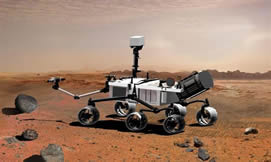Among other things, the Spanish technology will enable collecting data and information about wind, pressure, humidity and temperature of the atmosphere, as well as levels of ultraviolet radiation at the Martian surface.
Specifically, the Astrium España company, through EADS Casa Espacio, has built a high gain antenna system that will be incorporated into an unmanned spacecraft going to Mars. NASA expects to launch this mission in the fourth quarter of this year, from Cape Canaveral.
The Spanish antenna will send information directly to the Earth. It offers the advantage that, as the vehicle in which it is installed is steerable, it does not have to change its orientation in order to “speak” with the Earth.
In addition to the high gain antenna system, Spain will contribute a REMS sensor station (Rover Environmental Monitoring Station) for measuring the Martian environment. The program’s mission is to place a long-lived rover and mobile scientific equipment on Mars’ surface in order to carry out scientific studies that determine its past and present ability to sustain life. The rover will take soil and dust samples (in order to determine its geology and geochemistry) during one Martian year, which is equal to about two Earth years.
In sum, the antenna will improve the rover’s communications architecture, allowing it to communicate directly with the Earth. For its part the REMS station (supplied by the company Crisa) includes a series of sensors that will study the Martian environment (wind, pressure, humidity, atmospheric temperature, levels of ultraviolet radiation and ground temperature).
The NASA mission has a budget of $2,300 million; in addition to Spain it will include the participation of Russia, Canada, Germany, France and the United States.
